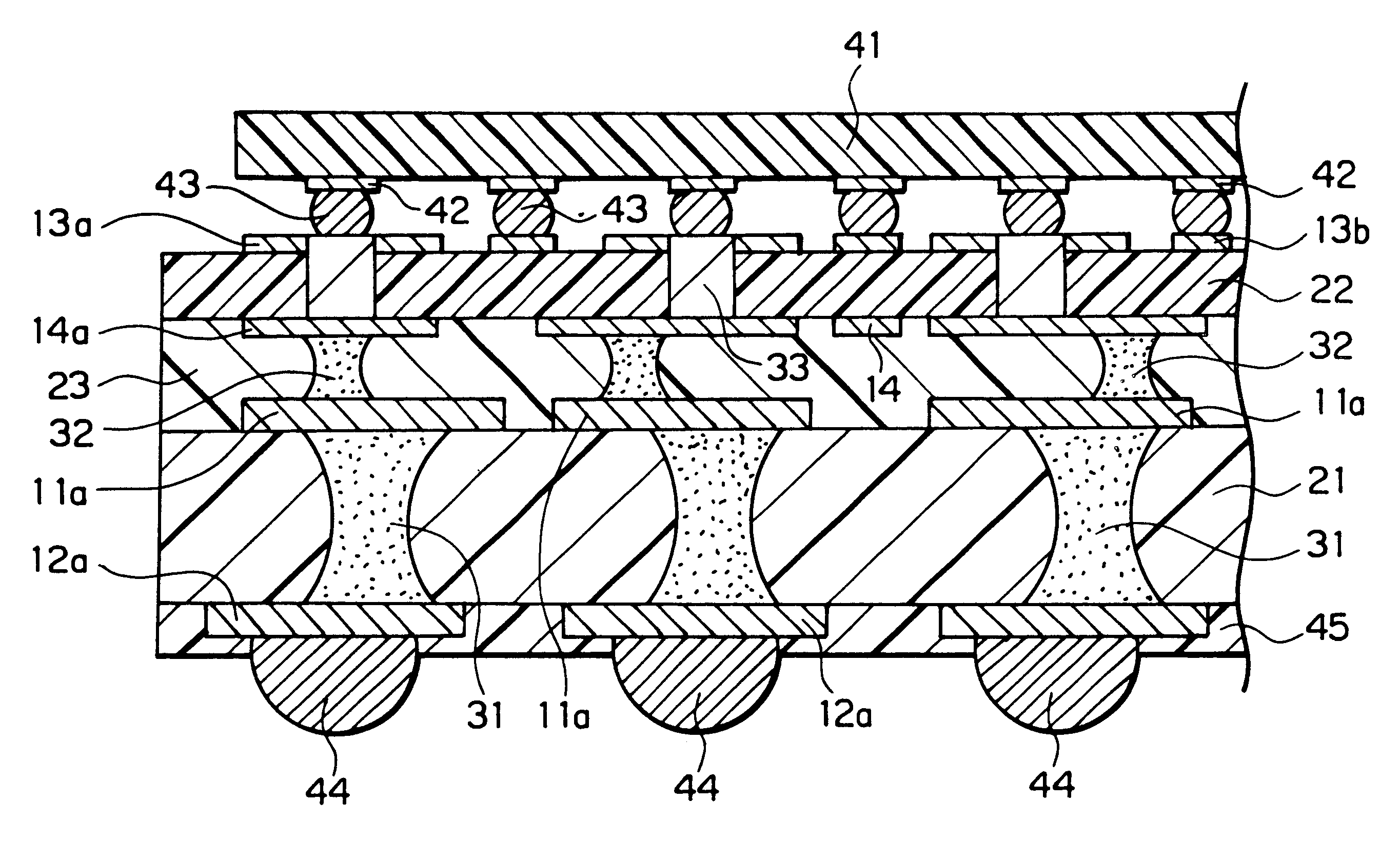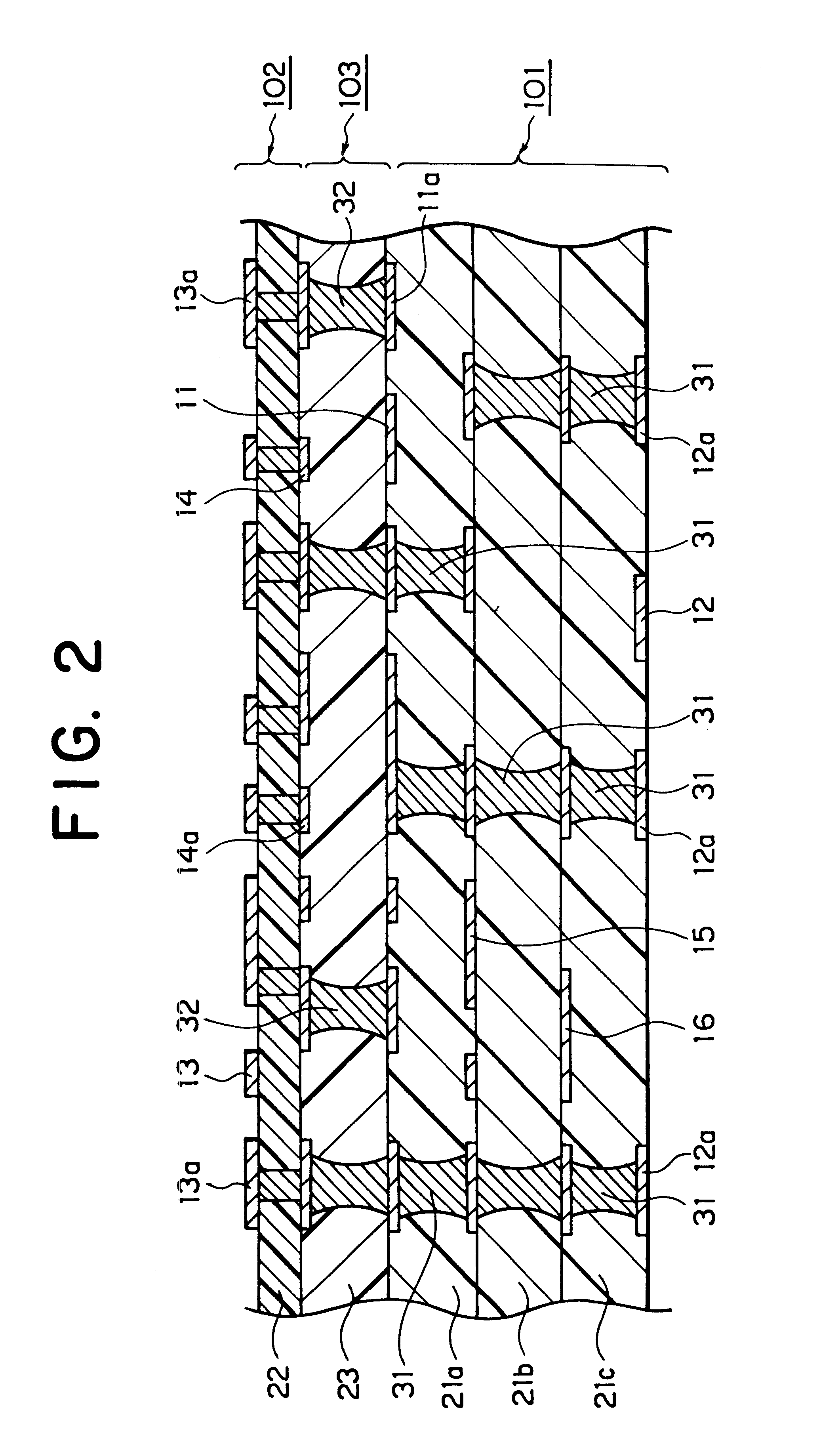Hybrid wiring board, semiconductor apparatus, flexible substrate, and fabrication method of hybrid wiring board
a technology of hybrid wiring and flexible substrate, which is applied in the field of hybrid wiring board, can solve the problems of difficult to form a finer wiring pattern, restricted thickness of build-up board, and inconvenient wire bonding technology and tab (tape automated bonding) technology cannot meet such requirements
- Summary
- Abstract
- Description
- Claims
- Application Information
AI Technical Summary
Problems solved by technology
Method used
Image
Examples
first embodiment
(First Embodiment)
FIG. 1 is a sectional view showing the structure of a hybrid wiring board according to a first embodiment of the present invention.
Referring to FIG. 1, a hybrid wiring board 10 is a laminate wiring board having four wiring layers 11, 12, 13, and 14. The wiring layer 11 and the wiring layer 12 are insulated with a first insulation layer 21 that is a rigid layer. The wiring layer 13 and the wiring layer 14 are insulated with an insulation layer 22 that is a flexible layer. The wiring layer 11 and the wiring layer 14 are insulated with a third insulation layer 23 that is more rigid than the second insulation layer 22. The wiring layers 11, 12, 13, and 14 have land portions 11a, 12a, 13a, and 14a as parts of their wiring patterns, respectively.
The wiring layers 11, 12, 13, and 14 are formed by patterning conductive metal foil such as copper foil.
The first insulation layer 21 is made of prepreg of which a glass cloth is impregnated with BT resin. The second insulation l...
second embodiment
(Second Embodiment)
In the hybrid wiring board shown in FIG. 1, the structure of which the rigid substrate made of the first insulation layer 21 (rigid layer) and the wiring layers 11 and 12 disposed on both the surfaces thereof and the flexible substrate made of the second insulation layer 22 (flexible layer) and the wiring layers 13 and 14 disposed on both the surfaces thereof are electrically and mechanically connected with the third insulation layer 23 and the conductive pillar 32 was exemplified. However, the present invention is not limited to such a structure. Instead, as the rigid substrate and the flexible substrate connected to the third insulation layer, substrates having three or more wiring layers may be used.
FIG. 2 is a sectional view showing the structure of a hybrid wiring board according to a second embodiment of the present invention. In the hybrid wiring board shown in FIG. 2, a rigid substrate 101 is a laminate of four wiring layers 11, 12, 15, and 16 and three in...
third embodiment
(Third Embodiment)
FIG. 3 is a sectional view showing the structure of a semiconductor package according to a third embodiment of the present invention.
The semiconductor package shown in FIG. 3 is a BGA package of which a semiconductor device 41 is mounted on the hybrid wiring board 10 shown in FIG. 10 according to the present invention by flip-chip bonding method.
The semiconductor device 41 is a bare chip. The semiconductor device 41 has a connecting pad 42 connected to an integrated circuit disposed in the semiconductor device. In this example, 900 connecting pads 42 are disposed on the lower surface of the semiconductor device 41 at pitches of around 0.35 mm in a full grid pattern.
A wiring layer 13 disposed on a second insulation layer 22 (flexible layer) of the hybrid wiring board has a connecting pad 13b or a via land 13a corresponding to the connecting pad 42 of the semiconductor device 41.
The connecting pad 13b or the via land 13a is bonded to the connecting pad 42 of the semi...
PUM
 Login to View More
Login to View More Abstract
Description
Claims
Application Information
 Login to View More
Login to View More - Generate Ideas
- Intellectual Property
- Life Sciences
- Materials
- Tech Scout
- Unparalleled Data Quality
- Higher Quality Content
- 60% Fewer Hallucinations
Browse by: Latest US Patents, China's latest patents, Technical Efficacy Thesaurus, Application Domain, Technology Topic, Popular Technical Reports.
© 2025 PatSnap. All rights reserved.Legal|Privacy policy|Modern Slavery Act Transparency Statement|Sitemap|About US| Contact US: help@patsnap.com



